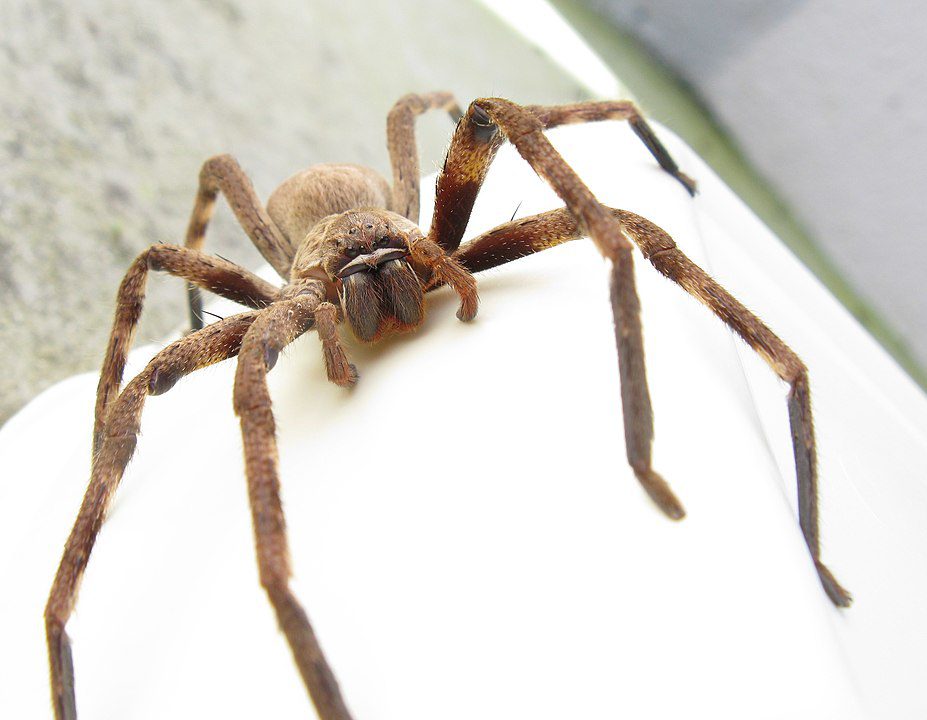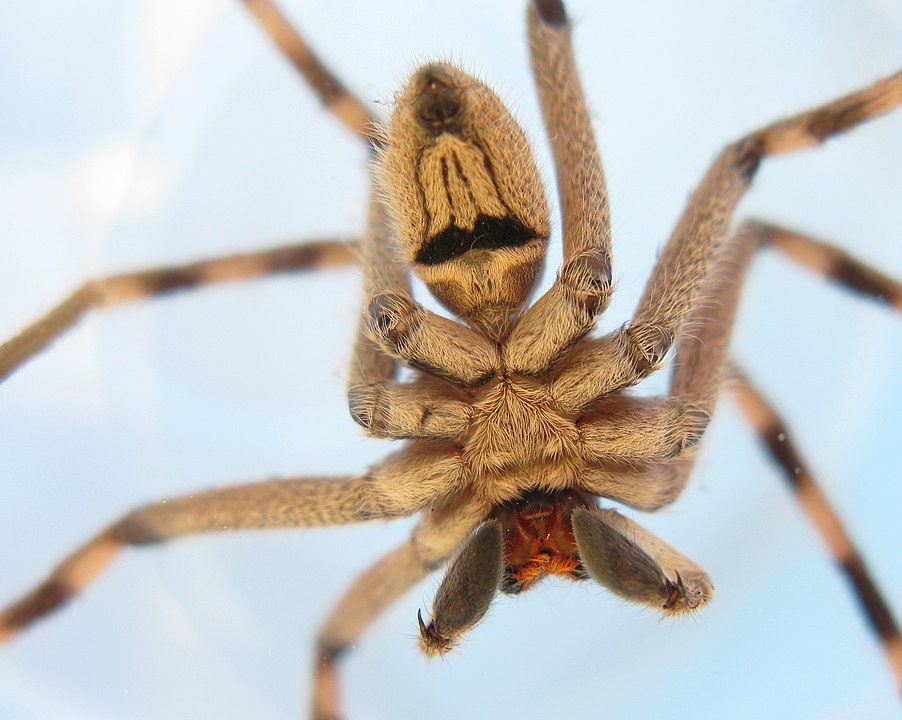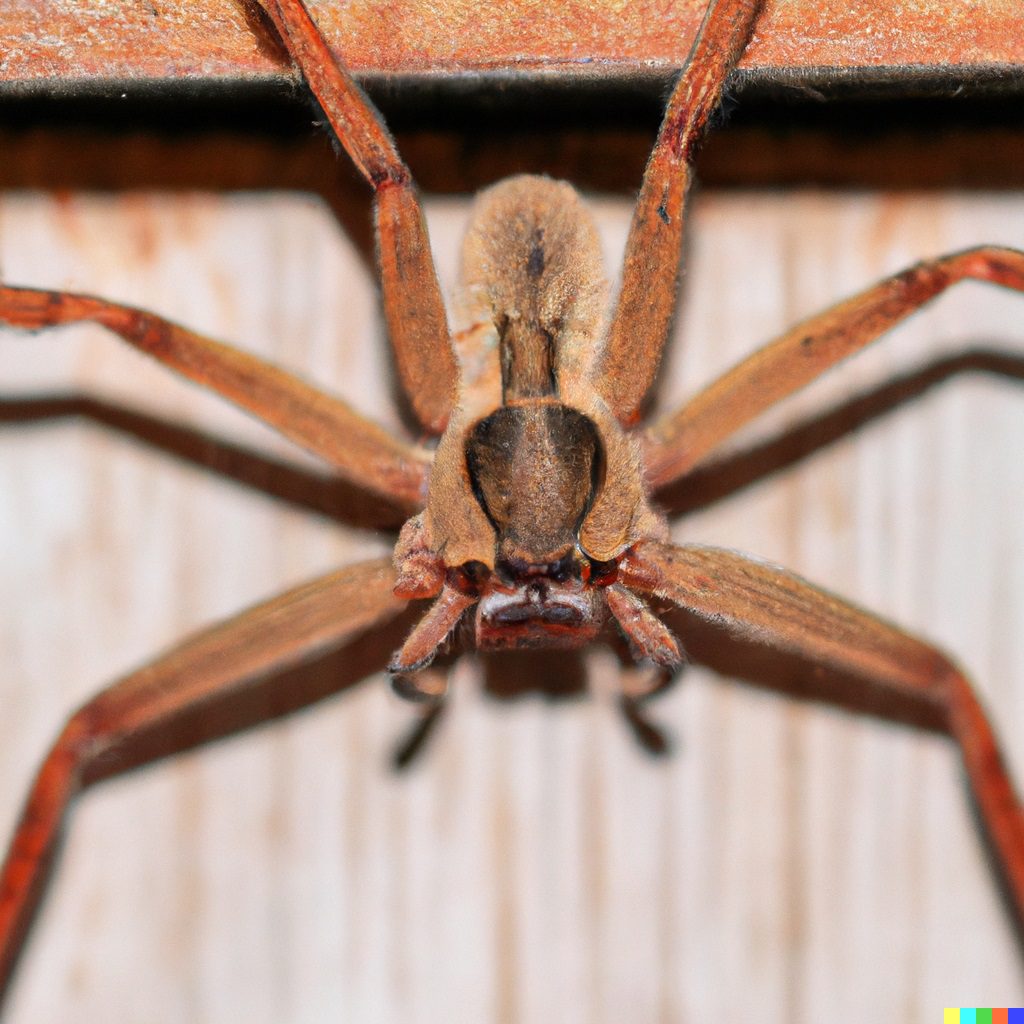Behold the Huntsman Spider: Australia’s Giant, Creepy-Crawly Arachnid
Australia is home to a wide variety of spiders, but none quite as impressive and awe-inspiring as the Giant Huntsman Spider. This species—scientifically known as Heteropoda maxima—is one of the largest species in the world, reaching leg spans of up to 30 centimetres (12 inches).
Its sheer size makes it an intimidating presence in its native environment; however, with some knowledge about this fascinating creature, we can learn to appreciate it from afar and understand why such a unique spider calls Australia home.
The Giant Huntsman Spider has evolved over hundreds of thousands of years to adapt itself perfectly to the Australian climate. With hairy legs that are particularly adept at gripping surfaces and eyesight so sharp they can detect movement up to three meters away, this arachnid’s features make it ideally suited to life on the continent. It is no surprise that these spiders have been able to thrive in their natural habitat since prehistoric times.
Despite being largely unknown until recent years, interest in the Giant Huntsman Spider has grown exponentially due to its remarkable attributes and mysterious behaviour. As more people become familiarized with this incredible species, we come closer together in our mutual appreciation and understanding of nature’s wonders.
Overview Of Species
The huntsman spider, a species widely found in Australia, belongs to the family of arachnids. These spiders are known for their large size and their ability to rapidly disperse across sprawling distances by scurrying out from underneath rocks or upon trees and other objects. The giant huntsman spider is one of the largest members of this species, with some specimens reaching up to 12 inches (30 cm) in leg span.
This particular Australian spider has adapted well to various climates and habitats — ranging from deserts and rainforests to suburban areas — due to their wide range of food sources that include insects, small reptiles, amphibians, and even birds. As such, it is an important part of local ecosystems regardless of location. Generally speaking, these spiders have dark colouring on both the carapace and abdomen, which helps provide camouflage from predators while they hunt prey or hide away during times of danger.
Giant huntsman spiders typically live alone outside of mating season when males seek out females for reproduction purposes. After mating takes place, fertilized eggs will be stored inside a sac until hatching time, when baby spiders emerge ready for life’s adventures.
Classification of Australian Huntsman Spider
Scientific Species Name: Heteropoda venatoria Genus: Heteropoda Class: Arachnida Family: Sparassidae Order: Araneae Subphylum: Chelicerata Phylum: Arthropoda Kingdom: Animalia
- The Australian Huntsman Spider is a large species of spider found throughout Australia and Southeast Asia.
- It belongs to the Heteropoda genus, which includes other species of huntsman spiders found around the world.
- Huntsman Spiders are classified under the Arachnida class, which includes spiders, scorpions, ticks, and mites.
- They are members of the Sparassidae family, commonly known as huntsman spiders or giant crab spiders.
- The Order Araneae includes all spiders, and the Subphylum Chelicerata includes arachnids, horseshoe crabs, and sea spiders.
- Huntsman Spiders belong to the Phylum Arthropoda, which comprises joint-legged invertebrates, including insects, arachnids, and crustaceans.
- The Australian Huntsman Spider is a member of the Animalia Kingdom, including all Earth animals.
10 interesting Facts About The Australian Huntsman Spider
- The Australian Huntsman Spider is one of the largest species of spiders found in Australia, with some individuals measuring over 15 cm across.
- They are known for their distinctive flattened bodies and long, spindly legs.
- Huntsman Spiders are primarily nocturnal and tend to hide in dark, sheltered places during the day.
- They are fast runners and can move quickly over both horizontal and vertical surfaces.
- Huntsman Spiders are known for their venomous bite but are not considered dangerous to humans.
- They primarily feed on insects and other small arthropods.
- Huntsman Spiders are often found in homes and buildings, especially during the summer months.
- They are not aggressive towards humans but may bite if provoked or threatened.
- Huntsman Spiders have been known to play dead when threatened, making them difficult to spot.
- Despite their fearsome appearance, Huntsman Spiders play an important role in controlling insect populations and are an important part of Australia’s ecosystem.

Distribution And Habitat
The giant huntsman (Heteropoda maxima) is a species of spider found in Australia. Though its geographical range is not limited to the continent, its habitats can be quite diverse. They are known for living among rocks and trees but have also been observed on man-made structures such as houses and vehicles. This species prefers the temperature range between 15°C and 30°C, though they may survive temperatures up to 40°C.
They thrive in arid or semi-arid environments with low humidity levels, making them well-suited for life in the Australian outback. As solitary hunters, these spiders often remain hidden under bark and tree crevices during the day and come out at night looking for prey. Their ability to quickly move across large surfaces makes them adept predators capable of catching insects, small reptiles, amphibians, and even other spiders.
Appearance And Anatomy
The Giant Huntsman Spider is an impressive specimen. It stands out for its immense size, reaching up to 15 cm (6 inches) in leg span, making it the largest spider species by diameter. Its formidable appearance is further enhanced with eight hairy legs and a mottled grey-brown colouration that helps give this spider its unique look.
In terms of anatomy, the Giant Huntsman Spider has two main body parts; the cephalothorax and the abdomen. The head comprises eyes. Chelicerae are used to catch prey, and fangs that inject venom into their victims. The legs have numerous small hairs on them, which help the spider sense its environment whilst also giving it extra grip when it moves around quickly. Additionally, spinnerets at the posterior end of the spider’s abdomen produce silk for web construction or egg sacs. Ultimately, these features make up one of nature’s most remarkable creatures – The Giant Huntsman Spider!
Diet And Eating Habits
The Giant Huntsman Spider is a carnivorous species that mainly feeds on insects, although they are known to occasionally feed upon other spiders.
- Insects: The primary source of food for the Giant Huntsman Spider is insects, such as crickets, flies and moths.
- Small mammals or reptiles: It has been observed that, in rare cases, these spiders have also fed upon small rodents, lizards and frogs.
- Carcasses: They can also scavenge carrion from dead animals if it is available near their habitat.
- Other Spiders: In addition to its diet of insects, the Giant Huntsman Spider will sometimes attack and consume smaller spider species within its vicinity for sustenance.
Due to the fact that this spider prefers warm climates with plenty of vegetation, insect prey is abundant in their environment, allowing them access to ample food sources throughout the year. This ensures healthy survival rates among this species despite competition from other predators like birds, snakes and lizards.
Furthermore, due to their relatively large size when compared to most other spiders, adult specimens can easily overpower any potential prey making hunting more successful than for some smaller arachnids who must compete with larger competitors for resources or retreat into burrows until things become safer outside again. As a result of all these factors combined, the Giant Huntsman Spider enjoys a steady supply of food while living out its life cycle in Australia’s rich ecosystems.
Reproduction And Life Cycle
The giant huntsman spider, native to Australia, has a semi-annual life cycle. While the lifespan of individual spiders may vary greatly, most female giant huntsman spiders live for 1-2 years. To reproduce, male giant huntsman spiders engage in courtship behaviour, such as waving their legs and tapping on the ground near females. If a female is receptive to mating, she will allow the male to approach her before they mate. After mating takes place, the female lays eggs which hatch into young spiders within two weeks. The newly hatched young are independent of this point onwards and disperse away quickly upon hatching.
Once the young have dispersed, adult males go through several moults before reaching maturity, while females reach maturity after just one moult. It should be noted that these lifecycle stages can take anywhere between 3-6 months, depending on environmental conditions such as temperature and humidity levels.
Furthermore, it is important to note that due to its size and aggression towards intruders in its habitat, the giant huntsman spider plays an important role in controlling insect populations in Australia’s ecosystem.
Predation And Defense Mechanisms
The Giant Huntsman Spider is an incredible arachnid species native to Australia. It has a variety of predation tactics and defence strategies it employs when hunting or defending itself from threats. In this section, we will explore the various behaviours that are commonly seen in these spiders.
First and foremost, it is important to understand how they hunt for prey. The Giant Huntsman spider uses its strategic vision and agility to locate potential prey items such as insects, lizards, small birds, snakes, and other arthropods.
When they find their target, they use quickness and stealth to ambush them with their powerful front legs and fangs, which can inject venom into their meal.
| Predation Tactics | Defence Strategies |
| Fast reflexes & agile movements | Aggressive posturing & stances |
| Stealthy ambushes | Smearing body fluids on attackers |
| Use of powerful fangs | Releasing hairs from the abdomen |
Once the food item has been captured or if the spider feels threatened by another creature, it may employ one of several defensive strategies at its disposal. These include aggressive posturing by raising up onto all eight legs and waving vibrant colours around its body in order to intimidate predators.
The Giant Huntsman spider can also expel smelly liquid from glands located near the top of its head or smear body fluid over its attacker’s eyes, temporarily blinding them long enough for the spider to flee. Furthermore, some individuals have even been known to release a cloud of fine silken hairs from their abdomens which irritates any would-be assailants’ respiratory systems, causing coughing fits while they make their escape.
Overall, the combination of extraordinary predation tactics combined with effective defensive strategies makes the Giant Huntsman Spider an impressive species perfectly adapted to survive in Australia’s harsh environment, where many creatures must compete for resources.
Interaction With Humans
The giant huntsman spider (Heteropoda maxima) is Australia’s largest spider species. It can be found inhabiting various areas, including caves, crevices of rock faces, and urban settings such as gardens and homes. This particular species has a fascinating relationship with humans; many Australians have grown to appreciate its presence in their living environment despite some initial fear or apprehension.
In terms of physical interaction, it is important to note that the giant huntsman is non-aggressive towards people – bites are rare and usually only occur if the spider feels threatened or provoked. As far as human benefit goes, this species helps protect against other pests by predating on insects like cockroaches, flies and moths which may otherwise invade one’s home. Additionally, their presence contributes to maintaining healthy ecosystems by keeping insect populations balanced. Therefore, they serve an important role within Australian wildlife and should be respected rather than feared when encountered during daily activities.
When considering how best to coexist with these spiders in our immediate environment, it is important to remember that prevention measures should always come first: sealing off cracks where possible will help keep them out of your house. If you encounter one inside, however, a gentle relocation outside using a cup or container is required for humane removal without causing harm either to yourself or the spider itself.
Conservation Status
The conservation status of the giant huntsman spider (Heteropoda maxima) has been a topic of debate since its discovery in 2001. The species is considered to be near threatened due to rapid declines in many areas, primarily because of habitat loss and human hunting methods that have led to population decline. As an endangered species, several ongoing conservation efforts are underway for this species.
First, habitat restoration projects aim to create more suitable habitats for these spiders by creating denser vegetation cover and providing shelter from potential predators or weather conditions.
Second, research has been conducted better to understand the natural behaviour and ecology of Heteropoda maxima so as to develop effective management strategies which could help conserve their populations. Lastly, education programs have been launched across Australia in order to raise public awareness about this fascinating species and encourage people to take part in local conservation initiatives such as planting native plants or reducing pesticide use in gardens where these spiders can live safely.
These various conservation efforts demonstrate how much value humans place on these remarkable creatures and highlight the importance of preserving our natural environment if we want these unique animals to continue thriving.
Cultural Significance
The giant huntsman spider is an iconic species in Australia, with its cultural significance deeply entwined with the land and mythology of Aboriginal people. The spiders have been included in the artwork, stories and traditional practices for centuries. They are believed to be a symbol of protection, wisdom and strength among many indigenous tribes across the continent.
In modern times, these majestic arachnids have become popular as motifs in artworks, such as sculptures and paintings. Often portrayed on dot-style canvas or carved into wood panels, these images depict movement and maturity within the aboriginal culture.
Additionally, depictions of giant huntsman spiders can also be found in songs and storytelling, where it is thought to represent courage against adversity. This has made them one of the most recognizable symbols of Australian identity nationally and internationally.
Fun Facts
The giant huntsman spider is a species of spider found mainly in Australia. It has been observed to reach sizes up to 15 centimetres, making it one of the largest known hunting-style spiders in the world. This species of spider is also distinguished by its long legs and flat bodies, enabling them to move quickly over large surfaces easily.
Due to its size and unique adaptations, this spider can be an intimidating creature for some people. Nonetheless, many interesting facts about these spiders help us better understand them.
For instance, although they appear quite frightening due to their large stature, they are considered harmless to humans as they do not possess venom strong enough to cause any significant effects when bitten. In addition, despite being nocturnal creatures, they have excellent eyesight during the day and use this feature for hunting down prey more effectively than other arachnids.
This particular species of Australian spider may seem daunting at first glance; however, understanding their behaviour and lifestyle can help us appreciate what extraordinary creatures they truly are. By learning about how these animals live amongst us, we can gain insight into our own environment and foster respect for nature’s most majestic inhabitants.

Frequently Asked Questions
How Long Do Giant Huntsman Spiders Live?
Giant huntsman spiders are a species of arachnids found in Australia. They are among the largest spider species, measuring up to 30 centimetres across with leg spans of over 25 centimetres. A common question that arises when discussing giant huntsman spiders is how long they live. In order to understand this topic better, it is important to look at existing research on the lifespan and longevity of these particular spiders.
Studies have shown that the average life expectancy for an adult giant huntsman spider is about two years. While some individuals may live longer than this, most will not exceed three years due to predation or other environmental factors. An important factor contributing to their short lifespans is their tendency to reproduce quickly, which can lead to a higher rate of mortality amongst juveniles and young adults.
Additionally, many of them do not survive past one year in captivity due to specific needs regarding living conditions and food sources that are difficult for humans to replicate in a controlled environment.
Therefore, while there is still much unknown about giant huntsman spider lifespans and longevities, existing research has demonstrated that they typically only live between two and three years in natural environments before succumbing to death from either predators or environmental causes. It should also be noted that even if they manage to stay alive longer than expected, captive specimens rarely outlive one year due to unsuitable habitats and dietary requirements.
What Type Of Habitat Does The Giant Huntsman Spider Prefer?
The giant huntsman spider is a species of spider found in Australia and other parts of the world. This large arachnid has become an iconic creature due to its size and unique biology. To better understand this fascinating species, it is important to explore its preferred habitat.
Giant huntsman spiders are generally found in warm climates with plenty of shade, such as forests or caves. They may also be spotted near human development, where they can find shelter from extreme temperatures and predators. These spiders prefer areas where foliage can provide camouflage and protection in their natural environment. As well as providing cover for hunting prey, dense vegetation offers ideal conditions for courtship activity and egg-laying sites.
In some parts of Australia, conservation efforts have been implemented to protect the habitats of the giant huntsman spider and other native wildlife species. These measures include monitoring populations; managing wildfires; creating buffer zones between agricultural land and conserved areas; restricting access by humans into certain locations; and introducing non-native plantings that can act as barriers to further development in the area.
All these steps help ensure that future generations will continue to benefit from the presence of these remarkable creatures in their natural surroundings for many years to come.
Are Giant Huntsman Spiders Venomous?
The giant huntsman spider (Heteropoda maxima) is a species of arachnid that can be found in Australia. It has gained notoriety for being the largest huntsman spider, with some individuals growing to over 30 centimetres across their legs. This has led to questions about whether or not these spiders are venomous and pose a risk to humans.
Research into the venom produced by this species indicates that it is capable of producing venom like other spiders, but its toxicity towards humans remains unknown. Studies have shown that they will bite and inject venom into their prey when threatened.
However, any toxic effects on humans from such bites remain largely unreported in the literature. Although there have been reports of mild skin irritation and burning sensations at the site of contact with the spider’s fangs, no serious health effects have been reported so far.
It is, therefore, likely that while giant huntsman spiders may possess venomous capabilities, they do not appear to pose significant risks to human health. In addition, due to their large size, it is highly unlikely that most people would ever come close enough to one of these spiders for them to become a threat anyway.
How Many Eggs Does A Female Giant Huntsman Spider Lay?
Female giant huntsman spiders lay eggs for reproduction. It is estimated that a female can produce anywhere from 50 to 200 egg sacs, with each containing up to 100 individual spiderlings. To understand the process of how they reproduce, one must first look at their anatomy and behaviour:
- Anatomy: Female giant huntsman spiders have two separate sets of reproductive organs, allowing them to store sperm in order to fertilize multiple batches of eggs over a period of time without needing additional mating opportunities. They also possess an ovipositor – an organ used for laying eggs – which helps them deposit their eggs into webbing or other suitable material before covering it with silk secretions.
- Behaviour: After mating, females will often seek out sheltered areas such as logs or rocks where they can construct nests for their egg sacs. Once these are constructed, she will then proceed to lay her eggs within the nest before sealing it off securely with more silk secretions. This ensures that the young spiderlings are adequately protected until they hatch approximately 4-8 weeks later.
The reproductive cycle of female giant huntsman spiders highlights the fascinating adaptations seen throughout nature. Not only do these creatures demonstrate remarkable defensive strategies when threatened by predators, but they also display great foresight when it comes to preparing habitats for their offspring too.
Furthermore, this species provides an interesting example of parental care since some individuals may even stay near their nests after depositing their eggs in order to guard against potential threats. These unique features make the giant huntsman spider a fascinating creature to observe and an integral part of the Australian ecosystem that deserves our attention and respect.
What Is The Conservation Status Of The Giant Huntsman Spider?
The conservation status of the giant huntsman spider is a topic that continues to draw attention in Australia and abroad. Species belonging to the genus Heteropoda – which includes the giant huntsman spider – are known for their large size, making them an intriguing species among arachnologists. As such, significant research has been dedicated to understanding this extraordinary creature’s conservation status.
Studies have revealed that while some subspecies of the giant huntsman spider may be considered threatened or vulnerable by IUCN standards due to habitat destruction and other human-induced changes, most populations appear to be stable.
For example, in Western Australia’s Pilbara region, researchers have observed relatively high densities of Huntsman spiders despite land-clearing activities occurring within their habitats. Nevertheless, further research into population trends and threats posed by humans is necessary to inform effective management strategies in the future.
Given its impressive size and popularity with scientists worldwide, it is important that we take steps to ensure the continued survival of these remarkable creatures.
This involves taking action on multiple fronts, such as preserving remaining habitats from destruction; monitoring existing populations; recognizing potential new threats; implementing sustainable harvesting practices where appropriate; and engaging communities in education programs about how they can help protect these fascinating animals.
Conclusion
The giant huntsman spider of Australia is an impressive creature. It has a lifespan ranging from three to five years and prefers habitats such as caves and crevices where it can hide in dark places. It is not considered venomous, but its bite could be painful for humans if provoked. The female giant huntsman spider can lay up to 200 eggs at once as an egg sac, which she will protect until they hatch. In terms of conservation status, the giant huntsman spider is currently listed as the least concern on the IUCN Red List due to their wide range and adaptability.
Overall, this species of spider is fascinating to study due to its unique characteristics and behaviours. Further research should continue to understand how these spiders live and interact with their environment so that scientists may develop better strategies for managing populations across different parts of Australia.
Additionally, more information about the impact of habitat destruction on this species would help inform future management plans aimed at protecting them from further decline.
In conclusion, the giant huntsman spider is one of many remarkable creatures inhabiting Australia’s diverse landscapes. Its biology offers insights into arachnid behaviour while also providing opportunities for learning regarding environmental protection efforts within this region. Understanding more about this species’ life history allows us to appreciate its significance in local ecosystems while devising initiatives that ensure its continued survival throughout the continent.

